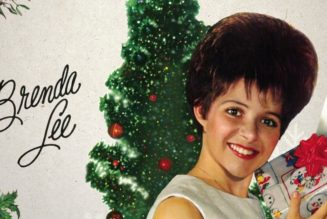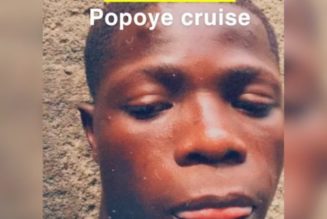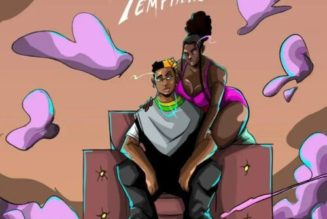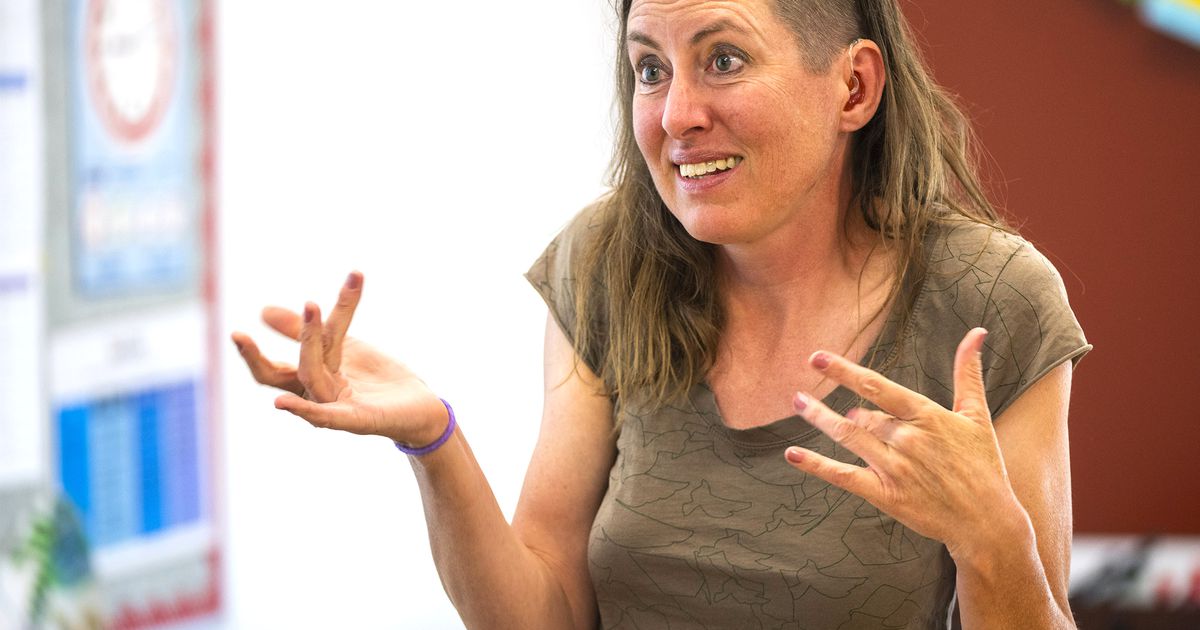
Six students come into a classroom at the Sorenson Multi-Cultural Center in Salt Lake City. There’s a yellow sign on the door: “Deaf and Musician at play.”
The students greet each other and their teachers — Cindy McAllister and Ben Brinton, who perform together as The Deaf and The Musician — with hugs and their sign-language names, the unique names given to each person based on their personality and other factors.
The class is part of a three-session program McAllister and Brinton teach about sign language and music.
“We had an overall goal to teach some sign language with broader concepts like deaf culture and music theory, in hopes to better explain the nuances of our performances, and encourage more interaction with students,” Brinton, the musician of the duo, said via email. “We figured we’d trade off teaching responsibilities and give each other one class to focus on and teach.”
(Rick Egan | The Salt Lake Tribune) Ben Brinton teaches a class about sign language and music, at the Sorenson Center, on Tuesday, June 13, 2023.
McAllister, who is deaf and performs sign language alongside Brinton, added, “We want students to walk away with awareness of differences in cultures, differences in languages and differences in experiencing music/sound. … We want them to walk away with what to do and what not to do when they encounter deaf people.”
The first class in the program gave the students a functional sign-language lesson and shared some insight on deaf culture. The second looked at song structure and interpreting metaphor. The third class focused on interactive karaoke.
The class was small, but focused, and allowed for more opportunity to pause, ask questions and discuss — it guided by the concept of relativity, “The idea that something is experienced relative to something else,” Brinton tells the class. “[This] concept [is] where we start to see why music becomes valuable.”
Brinton shared a quote from the late street artist Jean-Michel Basquiat: “Art is how we decorate space, music is how we decorate time.”
During the class, they spoke about different aspects of what makes music — defining terms like reverb, allegro, staccato, legato — and how the duo puts each to work in their performance.
For example, Brinton is a second tenor, and that lower vocal range makes it easier for McAllister to pick up on and interpret.
Throughout the two-hour class, McAllister and student Toby O’Hara shared insights to deaf culture. They talked about cochlear implants, which can be controversial within the deaf community.
(Rick Egan | The Salt Lake Tribune) Toby O’Hara makes a comment, during a class about sign language and music, at the Sorenson Center, on Tuesday, June 13, 2023.
McAllister turned the topic to the colors she chose for her molded hearing aid — orange with purple glitter. “I was talking about wanting color, because I want to stand out, I don’t want to blend in,” she said. “But that’s what a cochlear implant is. The hearing are trying to get the deaf to become more hearing.”
O’Hara talked about how batteries for their hearing aids can run out quite quickly, and joked that “it becomes tired.” The louder the environment, the harder the device needs to work, and concerts make that job even more difficult, he said.
The class discussed cultural sounds the deaf and hard-of-hearing community might not get — like the two-note warning music from “Jaws.” They also talked about dissecting metaphor devices in songs, like Brinton’s “Polka Dot Mercy” and “Blue on Black” from Kenny Wayne Shepherd.
Brinton and McAllister lead the class, but the students take a part in teaching, too.
Katie Price, who has a bachelor’s degree in deaf education and is already fairly fluent in American Sign Language, is one of those students.
What Price found most insightful, she said, “was making a list of all the things we as hearing people enjoy about music, and then how almost all of them on that list are things that deaf people enjoy — except for sounds.”
The class, she said, is great at raising awareness, but also showing how to interact with people from different backgrounds.
“It’s very comprehensive, where you get kind of both sides of deaf culture and experience and functional sign language on one hand, and then kind of introduction to music,” she said.
(Rick Egan | The Salt Lake Tribune) Cindy McAllister talks to Lisa Thurman during a class about sign language and music, at the Sorenson Center, on Tuesday, June 13, 2023.
Shannon Krug, who took the classes a month earlier, said that because the classes are modular, people can take all three and apply the lessons in the first two sessions to the third class — the translation karaoke party, which she said was fascinating.
“Sign interpretation is an amazing skill set,” Krug said, adding that McAllister taught some important lessons — like how the simple act of looking up lyrics before a concert can help with interpretation, and how she doesn’t think finger-spelling is true signing.
The overall message, Krug said, is to “try to just communicate and remember that it’s a living language and that’s what it’s for.”
McAllister said their classes are quite basic. It takes a while to understand deaf culture and how sign works. But it’s a start.
Brinton added that their class “touches on an interesting need to make performing arts more accessible and inclusive, that includes featuring a deaf artist (Cindy) and integrating ASL into the actual show, rather than setting it off to the side or in some other inconspicuous place.”
“If it’s a stepping stone,” Brinton said, “it’s more of a step towards promoting accessible shared experiences (i.e. show/concert), a step towards ASL being more than your ABCs, and maybe a step away from stigmas and social norms.”
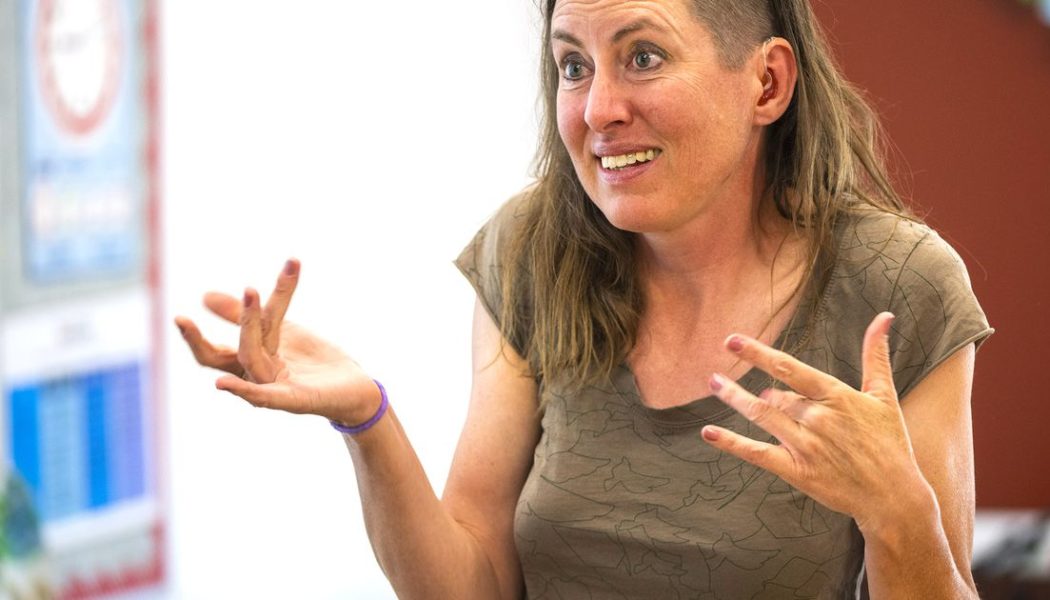


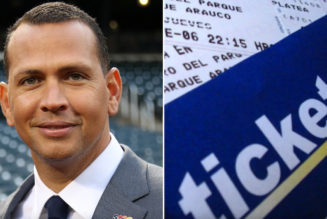
![Duncan Mighty – Obianuju [Throwback Music]](https://www.wazupnaija.com/wp-content/uploads/2021/06/duncan-mighty-obianuju-throwback-music-327x219.jpg)
